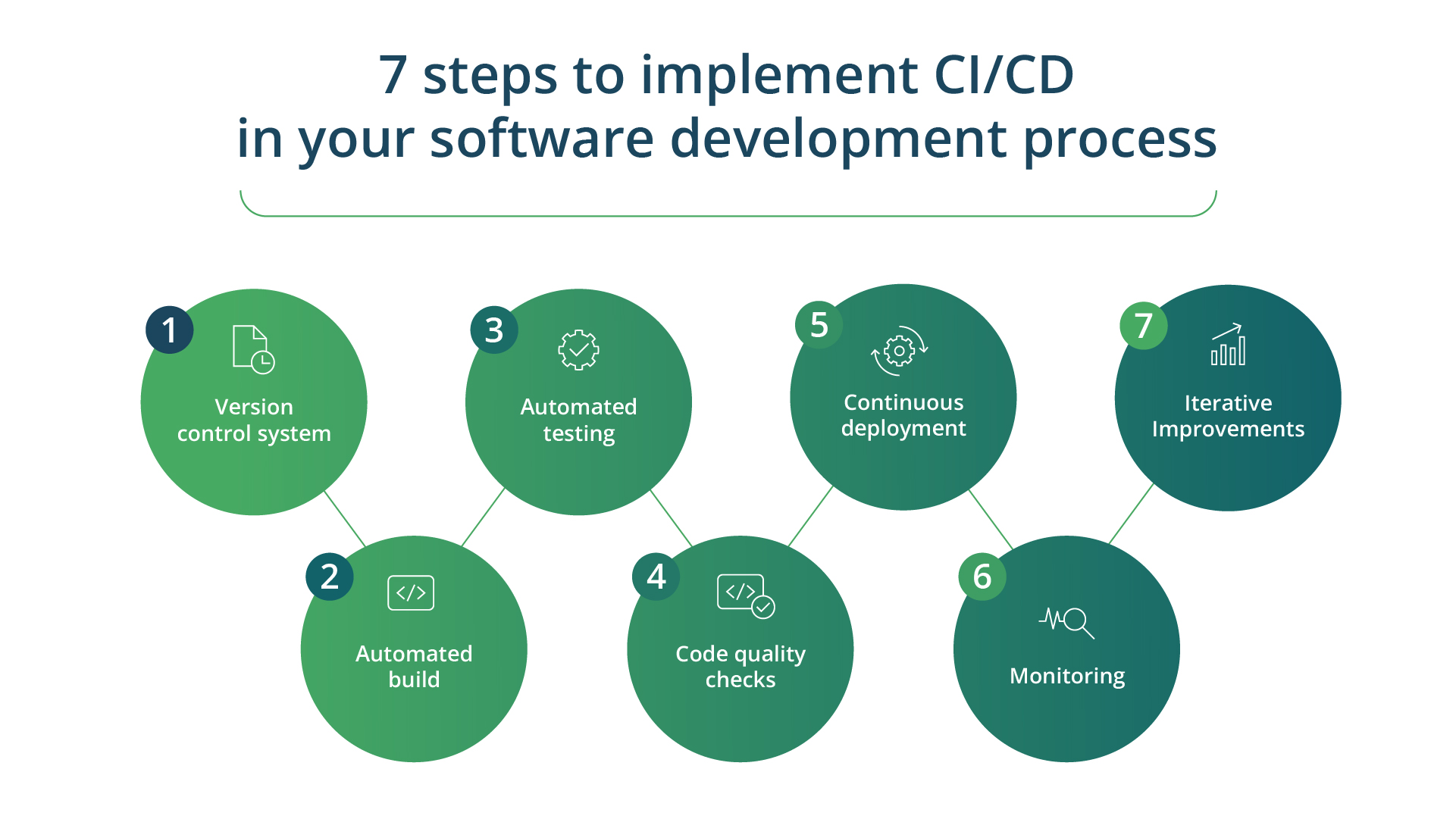
If you’re an owner of a tech-oriented business, you probably know that building, testing, and deploying software can be a time-consuming and error-prone process. That’s where Continuous Integration (CI) and Continuous Deployment (CD) come in — these practices automate the entire process, making it faster and more reliable.
This article will explore the benefits of implementing CI/CD in software product development. We’ll also walk you through seven simple steps to get started with your pipeline so you can deliver high-quality software faster and more efficiently than ever before.
CI/CD is an essential part of the DevOps toolkit. While ensuring that code changes are compiled, tested, and deployed to end-users automatically, it eliminates the need for tedious manual processes. CI/CD helps catch defects early, which leads to streamlined, more efficient developers’ work and reduced release cycles. Ultimately, it enables teams to deliver value to customers more quickly.
This approach is a departure from the old-school software development tactics, where small updates are rolled up into one big release and then thoroughly tested before deployment.
With CI/CD pipelines, developers can work in small iterations, continually building and testing their code.
The result? Faster delivery of high-quality software and happier customers who can access the latest features and bug fixes as soon as they’re available.
A well-executed CI and CD pipeline is a game-changer for organizations that want to be agile, efficient, and competitive in the fast-paced world of software development. The benefits of a seamless pipeline are numerous, including the following ones:
CI/CD pipelines reduce the risk of defects and improve software quality. By allowing QA engineers to identify and fix errors in real time, teams can avoid the cost and time spent on resolving defects, particularly those that arise with features already released to production. Developers can use the feedback loops provided by the pipeline to fine-tune the quality of the software continuously.
CI and CD practices enable quick rollback of code changes if there are any issues in the production environment after a release, minimizing production interruptions. This feature is handy when unexpected issues occur and teams need to take immediate action to restore service.
CI and CD facilitate better planning by ensuring that organizations have a well-organized backlog of work items and a continuous line of communication with clients. Teams can work collaboratively and iterate quickly, responding to changing requirements and feedback. Testing automation and constant monitoring ensure that applications perform optimally, improving the user experience and customer satisfaction.
CI/CD pipelines generate a large volume of logging data that can provide insights into system performance over time. This information aids observability, allowing teams to track critical performance indicators and respond proactively to issues. The pipeline becomes an essential tool for monitoring, troubleshooting, and optimization.
By automating the software delivery process, developers can save time and reduce manual intervention, leading to faster product delivery. Daily releases become a reality, and teams can focus on higher-value tasks instead of repetitive manual work.
CI and CD pipelines are cost-effective, improving code quality and overall ROI. By automating testing hooks at every stage, developers can fix issues early and avoid critical issues in the production environment. Teams can use the feedback loops provided by the pipeline to refine their processes continually, improving efficiency and reducing costs over time.
To implement Continuous Integration and Continuous Deployment in your software development process, you need to use a combination of tools and best practices. But where do you start? Here are seven simple steps to get your CI/CD pipeline up and running.

First off, you’ll need to use a version control system to keep track of code changes and collaborate with your team. This helps you stay organized and ensures everyone is on the same page.
Next up, automate your build process using tools like Jenkins, CircleCI, or Travis CI. This nifty trick ensures your code is always built correctly and reduces the risk of pesky errors.
We all know catching issues early is way better than dealing with them later. Automated testing using tools like Selenium is a must to reveal any issues early in the development process.
To ensure your code is top-notch, you must use tools to perform automated code quality checks. It ensures your code follows best practices and is easy to maintain.
Automation is key to success, and that is why automating your deployment process is crucial. This way, any code changes are automatically deployed to production, reducing the risk of manual errors.
Prevention is always better than cure — use monitoring tools to quickly catch any issues in the production environment. This way, you can immediately take corrective action and avoid any potential headaches.
Finally, don’t forget to continuously review your processes. By doing so, you can improve your automation and reduce the risk of errors, ultimately creating a CI and CD pipeline that enhances the quality and reliability of your code while accelerating your development process.
In this article, we’ve explored the benefits of implementing CI/CD in software product development and walked you through seven simple steps to get started with your pipeline.
By incorporating continuous integration and delivery into your business goals, you can effectively enhance your software delivery timelines and improve your bottom line.
Kanda’s DevOps services include consultation, implementation, and ongoing support for various DevOps tools and practices. We assist businesses in streamlining their software development processes by automating build, test, and deployment workflows and promoting collaboration between development and operations teams.
We work closely with clients to align DevOps practices with company objectives and optimize software delivery timelines, ultimately contributing to our client’s bottom line.
Are you seeking to improve the efficiency and effectiveness of your software development and delivery processes?



